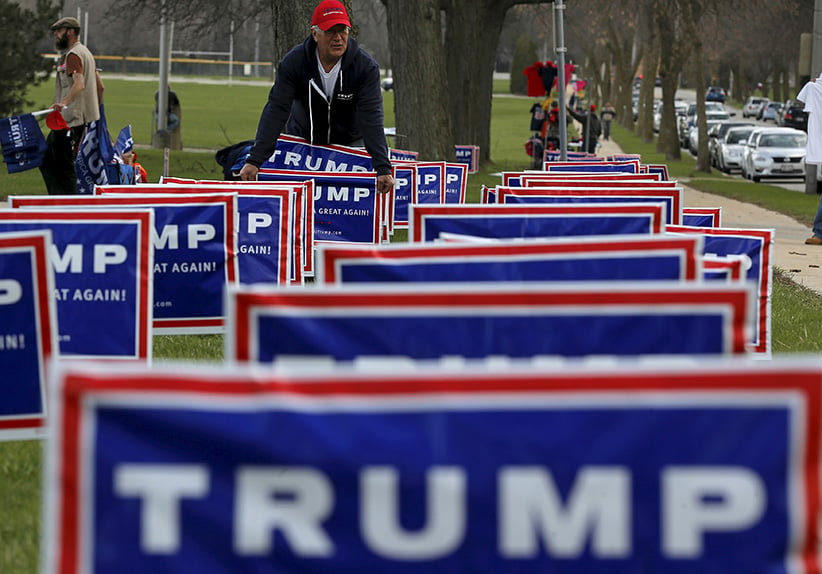Five underrated reasons for Trump’s win
After Trump’s win, a look at some news stories that now appear to have been bigger than they seemed at the time
Elam Stoltzfus plants lawn signs outside a U.S. Republican presidential candidate Donald Trump campaign rally in West Allis, Wisconsin, United States, April 3, 2016. REUTERS/Jim Young – RTSDEJT
Share

After Donald Trump’s upset victory over Hillary Clinton, there have been many articles and TV news reports discussing all the reasons why it happened: economic hardship, unauthorized immigration, racial resentment, Obamacare, and of course, the “damn emails.” But in a close election, there are always a lot of less-discussed stories that may have made some difference—especially among people who aren’t always on the radar of journalists.
Here are five stories that may have been more important to the election outcome than the U.S. press realized at the time.
1. Birth control. There were two recent cases, Burwell v. Hobby Lobby and Zubik v. Burwell, where the Obama administration went to the Supreme Court over its mandate that employers provide birth control as part of their health care packages. The administration’s position was that only religious institutions were completely exempt from the mandate. These cases—particularly Zubik, where the litigants were nuns—created a huge stir among conservative Christians, and many arguments that religious liberty was under threat. The Obama administration narrowly lost the first case, and would have lost the second case had Antonin Scalia been alive. This story did a lot to drive religious conservatives to support Trump in spite of their doubts about his character: he had promised to appoint judges with a broad view of religious conscience exemptions, while they knew for sure that Hillary Clinton wouldn’t.
2. Shooting of police officers. In July of this year, a sniper killed five police officers at a rally in Dallas. The killer, the chief of police said, “said he was upset about the recent police shootings. The suspect said he was upset at white people. The suspect stated he wanted to kill white people, especially white officers.” Both candidates, of course, denounced the killing, but Hillary Clinton’s statement also mentioned the need to root out “systemic racism” in police departments, while Trump took a more Nixonian, unambiguously pro-cop stand and kept taking it for the rest of the campaign. That made him and the Republicans in general able to benefit from a backlash against Black Lives Matter.
3. The Hyde Amendment. Hillary Clinton called for the repeal of the Hyde Amendment, a law passed in the 1970s barring federal funds from paying for abortion. 2016 was the first time the Democratic party had officially called for repealing the amendment, and it was a position that was not popular among more conservative Democrats, including Clinton’s own running mate. Clinton bet that the Democrats could shed the ambiguous attitude they used to have toward abortion and run on a proudly pro-choice platform, but she also gave religious conservatives another reason to embrace Trump, and conservative Democrats another reason to think that the party had moved too far left since the days of Bill Clinton.
4. The Orlando shooting. The massacre at a gay nightclub in Orlando, Florida, by a man “who’d pledged allegiance to ISIS,” was in itself bound to inflame fears of terrorism and draw some voters toward the more hawkish Republican approach. What may have made things worse for the Democrats, electorally, was that Hillary Clinton took the opportunity to make a case for more restrictive gun laws, while the New York Times editorial board didn’t mention ISIS and blamed the shooting in part on “Republican politicians who see prejudice as something to exploit.” It seemed to confirm conservatives’ worst stereotypes of liberals as being worried less about ISIS and more about coming after their guns and their religion.
5. Rising crime. The high crime rates of the 1970s and 1980s were a key part of U.S. politics, forcing Democrats like Bill Clinton to run to the right on issues like the death penalty and incarceration. Because crime fell in the 1990s, and continued to be historically low even during the recession, many Democrats assumed that the issue no longer worked for Republicans, and that it was time to talk more about criminal-justice reform. But violent crime rates have risen in the last couple of years, something that Donald Trump and his speechwriters made the focus of his speech at the Republican National Convention. Many fact checkers argued that this was an exaggerated problem because the crime rates were still low by historical standards. But it turns out that “things are better than they were in the ’70s and ’80s” is not a persuasive argument.